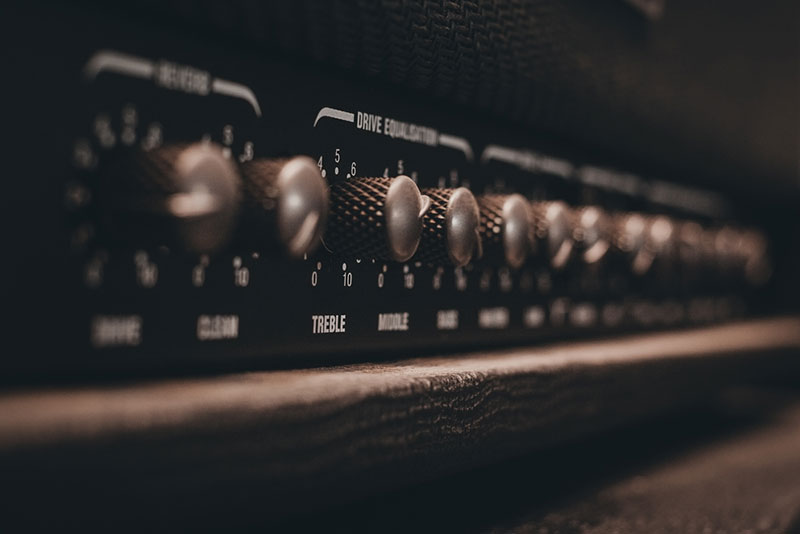Best Small Guitar Amp for Home Use Reviewed
If you’re looking for a quality guitar amplifier, there’s a chance that you might not have that much room for it at home. There are, however, some good options available for small guitar amplifiers — all without having to sacrifice sound quality, adjustment options, or ease of use. This article will look at several amplifiers and try to determine the best small guitar amp for home use.
The Fender Mustang I V2 is a 20-watt amplifier with 24 presets, 17 amp models and an 8″ speaker. It features USB connectivity, a headphone (line-out) as well as a portable music player MP3 (line-in) jack.
Its dimensions are 7.6 inches long, 15.5 inches wide, and 14.5 inches high. It has a weight of 17 pounds.
Its distinguishing features are the Fender Fuse software (which allows for a wider variety of amplifier presets) and the built-in ability to use reverb, echo, phaser, tremolo, and other effects.
- Compact design. The 8′ speaker and relatively short (14.5′) height is ideal for indoor use. It comes with 8 presets with 3 versions of each, totaling to 24 amp presets, allowing for mild, medium, and high distortions
- The Fender Fuse software allows for custom presets with rack and pedal effects, as well as different amplifier models
- This amplifier has a 1/8′ Mp3 Line-In jack that is compatible with Mac and other portable device auxiliary cables, a USB port, and the ability to use headphones with no adapters
- There is reportedly no ‘clean’ setting for the amplifier, plus there is no setting to override the already preset tones in March 2020 and is no longer supported by Fender
- The clean and metal sounds have been reported by some users to be indistinguishable, even after tweaking. The various settings have also been reported as being too similar; others have described them as muffled or harsh
The Boss Katana MKII-100 is a 100-watt solid state (that is, there is a current flowing to the output devices instead of voltage) 12-Inch speaker system. Its dimensions are 14 inches high, 18.5 inches wide, and 9 inches deep.
It has a weight of 23.5 pounds, and has one 12-inch speaker (there is another MKII-100 model also available with two 12-inch speakers).
The defining features of this amplifier are built-in effects options, “one-touch” automatic recall of effects settings, enhanced effects software, and USB, line, and phone/recording outputs.
- Ready-to-play effects include Reverb, FX, Mod, Delay, and Independent Booster. There are three variations with each effect. This will give you a total of 15 effects to choose
- The MKII-100 has a 0.5, 50, and 100-watt settings dial. The volume control has also been reported to have a high degree of range, from quieter ‘at home’ levels, indoors, and also outdoors performance levels
- With the POWER AMP IN you can plug in a multi-effects board, pre-amplifiers and amp modelers
- The amp lacks a foot controller (must be bought separately) and the effects are finite and pre-set
- Though generally a clean sound on the low watt setting, buzzing noises have been reported on the middle and high watt settings
- There have been issues with the BOSS Tone Studio software. Some users have reported that firmware updates were cumbersome, others needed to perform a factory reset to get the software working
The Orange Amps Electric Guitar Power Amplifier (Crush 20RT) is a 20-watt solid state amplifier with one 8″ speaker. It has a 3-band equalizer, with volume, gain, and built-in reverb dials.
Its dimensions are 7.87 inches long, 13.78 inches wide, and 15.75 inches high. It weighs 17.64 pounds. It has a headphones jack, an auxiliary in, and a guitar input port.
Its distinguishing features are dials for dirty and clean sounds, a built-in tuner, and separate dials for treble, middle, bass, and reverb effects.
- The smallest amplifier on this list, the Crush 20RT is an ideal home amplifier for those without too much storage space. It also is a relatively simple amplifier with a no-nonsense configuration board featuring headphones, guitar in, and aux in ports
- The dirty channel dial has been reported by some users to have plenty of gain. In addition to this, the clean dial has been noted for its fine-sounding clean ‘sparkling’ tones
- The built-in tuner allows for tuning without having to turn to external devices
- The settings aren’t complex and have their limits. Although there are treble and bass settings, the sound has been described as having not too much variation
- The amplifier is not known for great levels of volume, especially for band use. Some users had to turn up the volume to the 8 to 10 setting while performing with others
- The tuner has been reported to be inconsistent in terms of accuracy, and at least one user has found it to contradict the sounds from other tuning devices
Conclusion
Depending on your home, you may want to choose a smaller, lighter amplifier with better adjustments available for primarily volume, and secondarily, sound features and quality. Therefore, the Orange Amps Crush 20RT would come in first overall. Its no-nonsense board, light weight, simple features, and affordable price (around $190) would be great for the casual home player.
However, the Boss Katana MKII-100, with its different wattage settings and effects variations, would be a very close second. At the price, the MKII-100 may not be the best choice for those on a budget, and the larger, heavier dimensions of the amplifier are something to consider.
Finally, unless you can use the Fuse software, the Fender Mustang I V2 can not really be recommended. Though less expensive, (at around $140) its settings and sounds are limited in scope. But hopefully, you can take all these considerations into finding the best small guitar amplifier for home use.








Leave a Reply